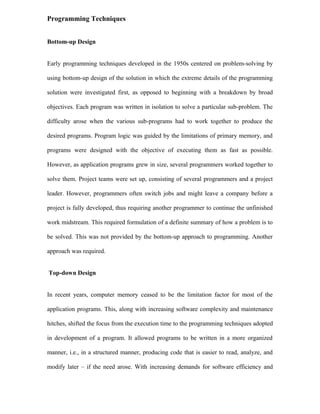
Programming techniques
- 1. Programming Techniques Bottom-up Design Early programming techniques developed in the 1950s centered on problem-solving by using bottom-up design of the solution in which the extreme details of the programming solution were investigated first, as opposed to beginning with a breakdown by broad objectives. Each program was written in isolation to solve a particular sub-problem. The difficulty arose when the various sub-programs had to work together to produce the desired programs. Program logic was guided by the limitations of primary memory, and programs were designed with the objective of executing them as fast as possible. However, as application programs grew in size, several programmers worked together to solve them. Project teams were set up, consisting of several programmers and a project leader. However, programmers often switch jobs and might leave a company before a project is fully developed, thus requiring another programmer to continue the unfinished work midstream. This required formulation of a definite summary of how a problem is to be solved. This was not provided by the bottom-up approach to programming. Another approach was required. Top-down Design In recent years, computer memory ceased to be the limitation factor for most of the application programs. This, along with increasing software complexity and maintenance hitches, shifted the focus from the execution time to the programming techniques adopted in development of a program. It allowed programs to be written in a more organized manner, i.e., in a structured manner, producing code that is easier to read, analyze, and modify later – if the need arose. With increasing demands for software efficiency and
- 2. programming standardization, a changed approach saw the programmers examining the problem as a whole and outlining the major steps to solve the problem. Then the process was repeated and the steps thus obtained were broken down in finer details. This is the top-down programming approach and is used in structured programming. Structured Programming Structured programming is a methodology that is part of a renewed emphasis on software engineering, which involves the systematic design and development of software and the management of the software development process. Software engineering views the development of a program as a coordinated activity involving people, tools, and practices; use of modern design; and development and management methods in an integrated approach. Structured approach involves the use of methods such as top-down program design and a limited number of control structures in a program to create tightly structured modules of program code. The effect of top-down design and structured programming has been used to lower the overall cost of programming. The structured approach promises to reduce the cost of developing and maintaining computer programs by standardizing program development and structures used. This increases the simplicity and accuracy, and at the same time minimizes programming and maintenance cost. A ‘traditional’ flexible and creative environment provided to the programmer often results in complex and difficult-to-read programs requiring much testing before they are error-free. These also become costly to develop and maintain. Structured programming, on the other hand, emphasizes group responsibility for program development. It also
- 3. brings in a standardization of program-design concepts and methods, which significantly reduces the program complexity. Organizations using structured programming have shown the following characteristics: • Programming Productivity: Programmers write more program statements per day with fewer errors. • Program Economy: The cost and time of program development and maintenance are reduced. • Program Simplicity: Programs are easier to read, write, correct, and maintain.
